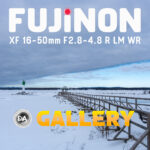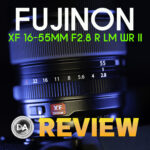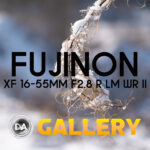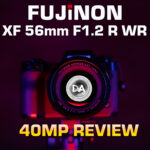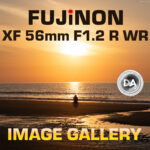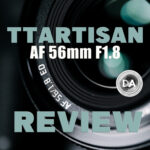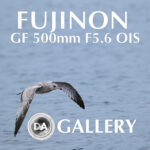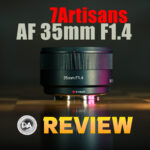
Fuji’s original 18-55mm F2.8-4 OIS was often used as proof positive that Fuji’s APS-C platform was the best. Before I began to test Fuji, I heard the lens hyped to epic proportions. When I got around to reviewing it in 2019, I was frankly a bit disappointed. In 2024 I revisited the Fuji standard zooms to see how they handled the high resolution 40MP sensors (the standard Fuji sensor was 16MP when those zooms were released!) The results were not encouraging. Neither the 18-55mm nor the premium 16-55mm F2.8 were really up to resolving that demanding sensor. Fortunately Fuji was already working (unknown to us all) to develop replacements for both lenses. While the new Fuji 16-55mm F2.8 R LM WR II is a Mark II lens with the same basic specs, Fuji chose to tweak the formula a bit with the replacement for the 18-55mm. The Fujinon XF 16-50mm F2.8-4.8 R LM WR has a new zoom range (16-50mm), a new maximum aperture range (F2.8-4.8 rather than F2.8-4), and Fuji has eliminated lens based stabilization (OIS) from the equation. What has remained is a fairly similar design and price tag ($699 or $400 in kit). Has the performance improved enough to justify an upgrade? Find out in either the thorough video review or by reading on in the text review!
Follow Me @ YouTube | Patreon | Instagram | Facebook | DA Merchandise | Flickr | 500px | X
Thanks to Fujifilm Canada for sending me a review copy of this lens. As always, this is a completely independent review. All opinions and conclusions are my own. I’m doing this review on a 40MP Fujifilm X-H2 camera. You can visit the product page for the 16-50mm here.
__________________________________________________________________________________________________
While the 18-55mm and the new XF 16-50mm have roughly similar size and weight, the engineers at Fuji went quite a different direction with the zoom range. Yes, on paper the zoom has 3mm less (+2 on the wide end but -5 on the telephoto), but, in practice, that extra 2mm on the wide end makes much more difference than the lost 5mm on the telephoto end. These days the higher resolution on cameras makes cropping in that extra 5mm effortless, but you don’t always have the chance to step back and get a wider shot. This also means much more engineering challenges, however, as the wider that a zoom lens goes, the more difficult it is to overcome the inherit optical challenges. What’s more, the XF 16-50mm is particularly wide. I compared it to the new 16-55mm F2.8 II and actually found that though both lenses are technically 16mm on the wide end, the XF 16-50mm is noticeably wider in practice.

If you look on both sides of the frame, there is more visible with the XF 16-50mm even shooting off the same tripod position. If your goal is getting as wide a field of view as possible in your zoom, that’s worth something. Furthermore, comparing it to the Sigma shows just how much wider that 16mm is compared to the 18mm starting point of the Sigma.

That’s the key reason why Fuji made this change to their zoom range. The XF 16-50mm also wins points for being compact, and it is the shortest and lightest of the three primary contenders in this class.

To be fair, however, it also cheats the most when it comes to aperture. The other two have a constant maximum aperture of F2.8, but while the XF 16-50mm start at F2.8 at 16mm, the aperture rapidly closes down. Because Fuji shows aperture stops in more precision than the typical one third stops I see on some cameras, you can the lens hit F2.9 by 17mm, F3 shortly after, and by 23mm (the next marked spot on the zoom range), the aperture is F3.3, F3.9 by 35mm, and right before 50mm it closes from F4.7 to F4.8. That places it at a significant disadvantage for light gathering compared to the other two. The Sigma had a shutter speed of 1/150th of a second at 50mm F2.8, when shooting my test chart. The XF 16-50mm needed a 1/50th exposure at 50mm, F4.8 in identical lighting conditions. That’s right under two full stops of light, and also makes the new 16-50mm roughly one half stop slower at 50mm than the older 18-55mm Fuji lens was. That was my first “red flag” when I saw Fuji’s development memo for the lens.

My second concern is that they decided to drop OIS (Optical Image Stabilization) in this model. That’s always a potentially limiting factor for a kit style lens, particularly one that is less bright than before. Fuji has worked to circumvent this limitation by only selling this lens in kit for models that have in camera stabilization, including the X-T50, X-T5, and X-S20. There will certainly be other models in the future, but expect them to always be mid-range bodies that have IBIS. That’s fine for those cameras in kit, but there will be people that want to upgrade their current lens or buy the lens for cameras without IBIS, and the lack of OIS will almost certainly give some potential buyers pause.

But there’s also a reason why Fuji’s compact standard zooms tend to become cult classics as they offer a far more premium experience than most “kit lenses”. When compared to the typical Sony, Canon, or Nikon APS-C kit lens, the XF 16-50mm is better built, brighter, has better autofocus, and has a better optical performance than those lenses tend to have. It’s also true that it costs at least twice as much as those lenses, and that’s where the XF 16-50mm will run into problems, as it might be hard to justify purchasing it over a lens like the Sigma 18-50mm F2.8. I’ll do my best to present the data to you in this review and let you decide.
Build and Handling
If you don’t speak “Fuji”, all of those letter in the name do actually mean something.
- R = Ring, or aperture ring
- LM = Linear Motor, the focus system in the lens
- WR = Weather Resistance
This latter feature is definitely a serious departure from most kit style lenses. Many first party manufacturers exclude weather sealing from their non-premium lenses, but the XF 16-50mm sports Fuji’s thorough approach to weather sealing, from rear gaskets to internal seals and coatings on the front element. This is one area of upgrade from the 18-55mm, which lacked weather resistance.

The Sigma 18-50mm does have a modicum of weather sealing in the form of a rear gasket, but this is one area where the Fuji lens is a bit more premium.
Because the XF 16-50mm is a variable aperture lens like the 18-55mm was, it has a slightly different approach to aperture control. It does have an aperture ring, but it doesn’t feature marked stops on the lens barrel because that information will vary somewhat with the focal length.

What we get is an endlessly rotating ring without hard stops, though with light clicks throughout. A small switch will allow you to select between manual aperture control or A (automatic) control from within the camera.

I would argue that the lack of physical markings and thus direct feedback on aperture makes using an aperture ring a little less attractive, as you’re going to have to be looking at a screen anyway to confirm what aperture is currently selected. On my X-H2, this isn’t too bad, as I can confirm via the top mounted LCD, which is reasonably ergonomically sound if I’m looking down at the camera and rotating the ring, but in cameras where there is only the rear LCD or a viewfinder (if so equipped), I’m not sure that reaching around the camera to the aperture ring makes more sense than just turning a command dial. Those that have used the 18-55mm in the past have probably already made their determination on what their preferred control scheme is, but those that are new to this type of design might find this aperture ring more trouble than its worth.
Fuji upgraded the number of aperture blades on the 16-55mm II from 9 to 11, but they haven’t made a similar decision here. The aperture blade count is 9, which is the same as the Sigma.

We’ll explore the dimensions of the lens a little more in a moment, but one huge bonus for the XF 16-50mm is that, unlike either of the competing lenses, it is an internally zooming lens. Both the Sigma and the Fuji 16-55mm II will grow in length when zoomed to the telephoto end, but the 16-50mm has a constant length due to that internal zoom. That makes it truly the most compact lens here, but also means that A) the balance will stay the same regardless of focal length when mounted on a gimbal B) there is less chance of getting dust into the lens and C) the zooming action is smoother than either the Sigma or 16-55mm II (the latter of which has rather poor zoom action for a premium lens).

The zoom action here is nice and smooth, making it much easier to do zooms during video than either of the other lenses.
Fuji’s standard is for AF | MF to be controlled from the camera, typically in the form of a camera-mounted lever, so there are no other buttons or switches on the lens. So far the idea of custom buttons seems to be reserved for telephoto lenses and not other lenses like this, which is a shame considering that those custom buttons can be a handy way to have additional control while shooting.

The final ring on the lens barrel is the manual focus ring, and I prefer it over the 16-55mm II’s ring as well. It has more weight and damping to it, making it feel a bit more like a true manual focus experience, though I find that Fuji lenses tend to manually focus in obvious steps rather than smooth linear pulls.

Fuji has managed to reduce a bit of weight from the lens it replaces. The 18-55mm OIS was 65 x 70.4mm and weighed 310g (11oz), whereas the new lens is 65 x 71.4mm (2.6 x 2.8″, or about the same size), but weighs just 240g (8oz). That makes it a full 70g lighter than the lens it replaces and 45g lighter than the Sigma. And, while the length is technically one millimeter longer than the 18-55mm, remember that the new lens is internally zooming and thus doesn’t extend at all like the previous lens did. I found the balance to be fine even when shooting on very small bodies like the new X-M5.

Another key area of improvement by Fuji is the amount of magnification. The 18-55mm could focus as closely as 30cm and achieved a pretty lackluster 0.15x magnification. The new lens can focus as quickly as 24cm, which may not seem like a big improvement, but that actually results in a 0.30x level of magnification. Fuji claims that with the crop factor this achieves a full frame equivalent of half life size (0.50x), which looks about right from my tests.

The amount of magnification is awesome, though the XF 16-50mm does lack some contrast at 50mm, and it feels like that is exacerbated up close. Fine details aren’t particularly well resolved because of the lower contrast.

You will get a little less magnification, but backing off the focal length a bit will allow you to lock in a little more contrast. Here’s an example closer to 35mm, and you can see that the detail pops more.

Overall, however, I think that most people will be pleased by getting an internally zooming lens – with weather sealing – and that weighs 70g less. What makes people love this design is the ability to get fairly solid image quality in such a compact package, and Fuji has definitely expanded that formula. I predict the decision to not include OIS will the most controversial move, however, and that will result in some owners of the 18-55mm electing to keep what they have.
Stills Autofocus
The XF 16-50mm is a definitely improved autofocus lens relative to the lens that it replaces, but autofocus on Fuji cameras remains frustratingly behind what I find on other platforms. The most recent 5.x firmware updates for my X-H2 have made some improvements to stills autofocus, and that helps autofocus feel pretty competent with the 16-50mm attached. Video autofocus remains a bit frustrating, however. With a first party lens like this, it becomes impossible to parse out what behavior is camera-specific and which is lens specific, as I will only review it on Fuji and not other mount. I’ll elaborate on individual performance in the section below, but I do want to add the caveat that (for Fuji) this and the new 16-55mm F2.8 II are very strongly focusing lenses.

The XG 16-50mm is equipped with LM, or a linear motor. This is the superior motor that Fuji uses, and it shows in quieter and faster performance than lenses equipped with a micro motor. This is a more reactive motor, and I found that it quickly locked onto eyes and delivered good accuracy.

You’ll notice that Fuji is doing a better job with precision, as focus is now on the iris rather than the upper hood of the eyelid as it often was in earlier iterations of their focus.

As per usual, there were times when focus didn’t want to grab a foreground subject and would get stuck locking on the background (even when the focus square was right on the foreground object).

This required either focusing on a higher contrast subject elsewhere but at a similar focus distance first (to get autofocus in the right area) and then autofocus would lock properly on the right subject.

I can hear a very light whirring if I put my ear next to the lens barrel during autofocus, but it is otherwise pretty silent.
In general, I would say that autofocus is really solid on the lens, and performance should only get better as Fuji gets better focus hardware in their cameras.
Video AF
I often find video AF pretty frustrating on Fuji. There tend to be more obvious steps in video pulls, the touchscreen is often unresponsive in trying to force autofocus changes, and tracking isn’t as sophisticated. A good focusing lens does help, however, and my frustrations were reduced somewhat here in some areas. Video focus pulls were some of the best that I’ve seen on Fuji, with faster, smoother, more confident pulls. The linear motor manages to avoid the obvious steps that I typically see with lenses equipped with either micromotors or STM motors. Sometimes (not always) focus will do a bit of microadjusting at the end before it settles on focus lock.
On a positive note, focus breathing is fairly low, making focus changes feel more cinematic and less abrupt.
But where the XF 16-50mm fails is on the reactiveness side of things. I tested a reactiveness sequence where I walked towards the camera and moved in and out of frame to see how the camera/lens reacted. It didn’t go particularly well, as the lens proved less reactive than the 16-55 II in that scenario, with focus adjustments coming pretty obviously late at times, leaving my face out of focus for awkward amounts of time. Focus would eventually get there if I paused long enough, but I definitely wouldn’t consider focus reaction times quick enough to be relied on.



My hand test (where I alternately block and then unblock the camera’s view of my face with my hand) also didn’t go great. The reactiveness was too slow, so about the time I would be either adding or removing my hand would the time when the lens would finally start to make the focus change.
Bottom line is that while the XF 16-50mm is better than the XF 18-55mm, it doesn’t quite achieve the level of focus performance as the more expensive XF 16-55mm.
Image Quality Breakdown
As discussed in the intro, I was underwhelmed by the performance of the XF 18-55mm even when I tested it on a 26MP sensor, so I had a strong suspicion things would be worse still on the 40MP sensor of my X-H2…and they were. Throughout most of the zoom range, the XF 16-50mm is a definite improvement, though the telephoto end leaves me a little underwhelmed still. At it’s best, though, the lens delivers great looking images. I backed off to 41mm, here, and with an F4.5 aperture.

Not only does this image look great when viewed full (good color, good general contrast), but it also looks great at a pixel level even on the extremely demanding Fuji 40MP sensor.

The optical formula is 11 elements in 9 groups, with a majority of those being exotic elements, including 3 aspherical and 3 ED elements. If you look at the MTF charts, you’ll see a lens that would have been fantastic on the lower resolution cameras of the past (the 15 lines/mm result) but that still looks pretty good (save the corners) on the higher resolution sensor (the 45 lines/mm) result.



The MTF chart for the 16mm end shows very impressive center and mid-frame results on one axis (Sagittal), but a fairly large separation between that and the Meridional axis. That typically points to lower contrast. The telephoto end is more linear in the drop, and suggests better contrast, though ironically this is pretty much the opposite of what I experienced in the lens I tested.
Both the Fuji zooms are better than the Sigma 18-50mm when it comes to fringing, though you can see the 16-55 II controls fringing better and also has better contrast.

That being said, if you get the 16-50mm in kit, it costs $400, while the 16-55 II costs a whopping $1200, so you would expect it to be better!
So let’s jump into some of the details.
First of all, how about vignette and distortion? Fuji has pushed the boundaries on the wide end, so the question is whether or not that extra width comes with strings attached. Here’s a look at what the distortion and vignette looks like if corrections are turned off.

There’s a lot of barrel distortion here, but not much more than before. I had to use a +21 to correct the barrel distortion, but the 18-55mm needed a fairly similar +19 to correct. You can see from the manually corrected result that there is a mild mustache pattern that remains. It isn’t obvious, however, and you probably wouldn’t notice it on anything but shooting a grid like this. Unlike the 16-55 II, where vignette has significantly increased, I actually find a little less vignette here. I could correct it with a +44, whereas the older lens needed a +59 in my tests.

On the telephoto (50mm) the distortion has inverted to a pincushion distortion, though it is fairly mild. I only needed a -4 to correct, while vignette was easily correctable with a +28 (only about a stop). So other than a mild increase of barrel distortion, things aren’t too bad.
Longitudinal chromatic aberrations aren’t quite as well controlled as the 16-55 II, but they aren’t bad.

You can see in this real world shot of snow that there is a very mild amount of fringing near the upper edge, but nothing significant at all.

Lateral chromatic aberrations show up near the edge of the frame in transitions from dark to light areas. Things look pretty decent on my chart testing, though you’ll see a bit more in a real world image with some bare branches near the edge of the frame a little further on in the review.

We’ve gotten through the early section without any big red flags.
So how about resolution? The 40MP Fuji X-Trans sensor tends to make all but the very sharpest of lenses look a little soft when viewed at high magnification levels, and it just so happens that my review standard is to examine results at a 200% magnification. That is a lot to ask of any lens, and the previous generation lens just didn’t really hold up under this level of scrutiny. Can the second generation lens pass the test? Here’s a look at the test chart that crops throughout the review come from:

And here is a look at the F2.8 crops at 16mm from the center, then mid-frame, and then extreme lower right corner:



The center and mid-frame look good here, though there is definitely some softening in the corners. I also saw very good centering, with consistently good performance in all four corners.
This is about the only point where the XF 16-50mm can compare (at least in the center) with the 16-55 II, as it has the same focal length and aperture, and can deliver similar levels of sharpness.

If we jump up into the upper left corner, however, we can see the superior performance of the 16-55 II.

Likewise the Sigma holds up pretty well in the center, but the corner performance is night and day.
Stopping down to F4 will produce a mild improvement in the center, a more noticeable improvement in the mid-frame, but little in the corners.

The corners only sharpen so far, and even F5.6 and F8, the prime landscape apertures, don’t really exhibit strong corner performances.

I think that bears out in real world landscape images, as while the center and midframe look pretty good, the corners are definitely not pin sharp. At the same time, if you look at normal viewing levels (the first image), the image looks fine.



The final crop also shows a bit more lateral chromatic aberrations that I prefer.
Because minimum aperture is F22, diffraction on a high resolution body like this is going to be more obvious. The results through F11 aren’t bad, but at F16 and F22, the softness from diffraction gets very obvious.

Moving on to 23mm (the next marked spot on the zoom ring) shows better performance across the frame, this time up to and including the corners. Maximum aperture is now F3.3:

The corners look pretty good.

Real world images around 23mm look very nice and crisp. This is definitely a sweet spot for performance.


Moving on to 35mm (where maximum aperture is now F3.9), I found above all a very consistent performance across the frame and across different apertures. The center wasn’t quite as sharp as at 23mm, but the midframe and corners are arguably better. You can see from the comparison below that the image isn’t really sharper at F5.6 than it was at F3.9.

Real world images at 35-40mm look very good.

At 50mm the reduced contrast has a bit of a negative impact on image quality. Maximum aperture is now F4.8, which means that the next full stop is F5.6 (F4.8 is about one half stop brighter than F5.6 or one half stop darker than F4). It’s an odd maximum aperture.
F4.8 is marked by lower contrast both on my chart and in real world results, and you can see that while stopping down to F5.6 helps, it doesn’t give us the kind of performance we’ve seen in the middle of the zoom range.

Corners look relatively strong, as they aren’t far behind the center.

When I directly compared the results from the 16-55 II (at F2.8) and the 16-50 (at F4.8), I found that the XF 16-50mm couldn’t really compare in contrast.

I suspect that those who will enjoy the lens the most will be JPEG shooters. The in camera JPEG image works better to sharpen and correct images than do most pieces of software with RAWs (X-Trans files remain a little difficult to sharpen), and Fuji’s colors are very nice.

A discussion of bokeh is a little complicated with a lens like the XF 16-50mm that has a significantly slower maximum aperture than the lenses that it competes against. I’ll reserve any comparisons to the Sigma 18-50mm as opposed to much more expensive 16-55 II. A consequence of a slower maximum aperture (F4.8 vs F2.8) is that depth of field is larger at equivalent focus distances, which means that the background is less defocused. That means that bokeh balls (specular highlights) are going to be much smaller, for example.

The geometry of the specular highlights is pretty good. Specular highlights are fairly round even in the corners, but the problem is that you won’t have an opportunity to strongly defocus a background unless you are very close to your subject.
Up close, the background is fairly soft.

Back up even a little bit, however, and the background is just not going to be very defocused.

Bottom line is that you’ll need to get pretty close to your subject if you want the background to be blurred.
Flare resistance is quite good. I didn’t see any real issues with either ghosting or loss of contrast whether shooting wide open:

…or when shooting at smaller apertures (F11, here):

I’m not quite as impressed with the optics of the 16-50mm as I was with the 16-55 II, but that is reasonable. There’s no reason why a lens that costs half as much should be as good. I do feel, however, that resolution and contrast hold up better on the new lens than did the older 18-55mm, and that’s really what matters the most. You can check out the image gallery if you’d like to see more images.
Conclusion
There is always going to be a place for a compact zoom lens that covers from this:

…to this:

While there will forever be those who defend the XF 18-55mm F2.8-4 as the greatest lens ever, the reality is that it was getting long in the tooth. A lens designed around a 16MP resolution standard just wasn’t capable of excelling on a 40MP sensor.
Fuji’s new XF 16-50mm F2.8-4.8 R LM WR has made a lot of positive strides. I particularly appreciate the internal zooming design, the addition of weather sealing, and the extra width on the wide end of the zoom range. It is more optically competent on the high resolution sensor. The added magnification level is also great.

But neither can I call the XF 16-50mm an unequivocal win for Fuji. Whereas with the 16-55mm they made a true second generation version of the lens, with the 18-55mm they altered the lens formula in a number of key ways. They made the lens wider, but at the cost of reducing the overall zoom ratio. I’ve heard some negative feedback from those who say they would prefer the extra 5mm on the telephoto end. Fuji also made the lens slower in aperture, with the shorter telephoto end also coming with the penalty of one half stop less light, and that loss of light does extend back at least as far as the 32mm range. It’s not just 50mm that’s “slower”, but 40mm, and 35mm as well. But perhaps most divisive will be the choice to eliminate OIS from the equation. This makes the similarly priced Sigma 18-50mm F2.8 more attractive as an alternative, as if both lenses lack OIS, then at least the Sigma has a constant F2.8 aperture, making it easier to keep up sufficient shutter speeds.

But, of course, The Fujinon XF 16-50mm F2.8-4.8 R LM WR has one key advantage over a lens like the Sigma: it is a first party kit lens. It might be hard to justify choosing it over the Sigma if one were choosing between the two lenses at retail, where the Fuji might cost anywhere between $150-200 more. But the highest volume of sales will come in a kit with a new camera purchase, and there we find a steep discount to $400, meaning that it would be the Sigma that would cost anywhere between $100-150 more (at least in the US market). And, the truth of the matter is that the XF 16-50mm will almost certainly claim its status as the nicest kit lens being sold with an APS-C camera.
Pros:
- Significantly reduced weight
- Internally zooming design
- Now weather sealed
- Goes wider than predecessor
- Improved magnification
- Fast, quiet autofocus
- Focus accuracy good
- Mostly low chromatic aberrations
- Good flare resistance
- Great color
Cons:
- No OIS
- Slower maximum aperture than previous lens
- Weak corners at 16mm
- Low contrast at 50mm
- Expensive unless purchased in kit
_________________________________________________________________________
GEAR USED:
Purchase the Fuji 16-50mm WR @ B&H Photo | Adorama | Amazon | Camera Canada | Amazon Canada | Amazon UK | Amazon Germany
_____________________________________________________________
Purchase the Fujifilm X-H2 @ B&H Photo | Adorama | Amazon | Camera Canada | Amazon Canada | Amazon UK | Amazon Germany
_______________________________________________________________
Purchase the Fujifilm X-T5 @ B&H Photo | Amazon | Camera Canada | Amazon Canada | Amazon UK | Find it Used at KEH
________________________________________________________________
Purchase the Fujifilm X-S20 @ B&H Photo | Adorama | Amazon | Camera Canada | Amazon Canada | Amazon UK | Amazon Germany |
_________________________________________________________________
Want to support this channel? Use these affiliate links to shop at: B&H Photo | Amazon | Adorama | Camera Canada | Amazon Canada | Amazon UK | Ebay | Make a donation via Paypal
Buy DA Merchandise https://bit.ly/TWIMerch

Keywords: Fuji 16-50mm, Fujinon 16-50, Fuji, Fujinon, XF, AF, Autofocus, 16-50mm, F2.8-4.8, R, WR, LM Weathersealing, Fuji 16-50mm F2.8-4.8 R LM WR II Review, f/2.8, Fuji X, Fujifilm, X-mount, APS-C, Review, Telephoto, Action, Tracking, Hands On, Dustin Abbott, Real World, Comparison, Sharpness, Bokeh, Flare Resistance, Autofocus, Image Quality, Sample Images, Video, Photography, Fujifilm X-T5, Fujifilm X-H2, let the light in, #letthelightin, DA

